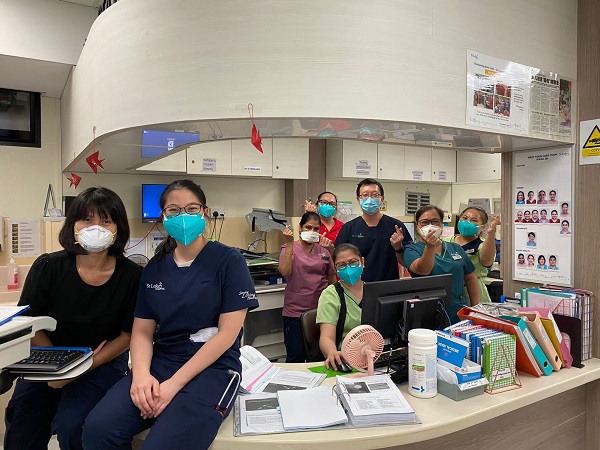Alongside National University Hospital (NUH) and Alexandra Hospital (AH), St Luke’s Hospital was also part of the Next Generation Electronic Medical Record (NGEMR) go-live exercise, and the first VWO Community Hospital to do so. This was particularly important for St Luke’s Hospital, as a significant number of referrals to St Luke’s Hospital come from National University Health System (NUHS). Being on the same medical record system, St Luke’s Hospital is able to enhance seamless quality care for their patients.
A game changer for St Luke’s Hospital, Next Generation Electronic Medical Record (NGEMR) now allows:
- doctors from St Luke’s Hospital to access more comprehensive clinical information from acute hospitals also on NGEMR. Previously, doctors could only view a summary of case notes from National Electronic Health Record (NEHR), and doctors from St Luke’s Hospital had to call up their counterparts if they require clarifications on the patient’s care plan.
- staff of St Luke’s Hospital to personalise individual user’s workspace for easy access of information, order activity and frequently used documents. With the transition to NGEMR, patient information can now flow seamlessly between St Luke’s Hospital and other healthcare institutions, thus translating into better patient outcomes and work efficiency for staff.

Photo credit: St Luke’s Hospital
Change Management Measures in place
The NGEMR journey at St Luke’s Hospital started in 2018 with collective efforts from all departments to ensure operational readiness for the transition.
In 2021, 30 staff underwent training and were tasked to oversee development, implementation and training of St Luke’s Hospital NGEMR users in various capacities. The St Luke’s Hospital team also received guidance from IHiS and adopted a global approach to the transition to NGEMR.
From the guidance, they also contextualised these plans to their operational needs. To deal with the change in systems and to better prepare staff, St Luke’s Hospital adopted measures such as a NGEMR Knowledge Base, NGEMR Kick-Off Day and Quarterly TownHall, supported by communication tools such as posters and emails to apprise staff of the exercise.
St Luke’s Hospital would like to share their appreciation for NUH’s support in facilitating the transition to NGEMR, through the sharing of communication materials and invitation for staff of St Luke’s Hospital to join their Grand Rounds and demonstration sessions.
The NUH team ensured data cleanliness when patient data flowed from NUH to St Luke’s Hospital, thereby reducing the need for clarification. The strong support is a testament to the close working relationship between NUHS, St Luke’s Hospital and IHiS and the close partnership between all parties.
Challenges during the transition to Next Generation Electronic Medical Record (NGEMR)
The St Luke’s Hospital team encountered the following challenges during the NGEMR transition, and they were able to overcome these with support from other staff of St Luke’s Hospital and working as a team.
1. Resources and manpower
NGEMR core project team at St Luke’s Hospital was lean to begin with, with the situation exacerbated by the two COVID-19 surges in 2021 and 2022, which stretched clinical staff and affected the NGEMR training schedule. As a result, staff of St Luke’s Hospital had to put in extra hours, with some sacrificing their weekends to come back for training. The St Luke’s Hospital NGEMR team also had to balance the system migration related tasks on top of caring for their patients, with a reduced manpower pool at times.
2. Global chip shortage
The global shortage of microchips led to a shortage of computer equipment such as laptops and printers which were crucial for testing and system migration. To overcome this issue, the St Luke’s Hospital NGEMR team put in extra work to look for additional suppliers to procure the required equipment.
Despite the above challenges, St Luke’s Hospital rose above these difficulties and were able to deliver a successful NGEMR go-live in February 2022, with no compromise to patient care and treatment.
“It hasn’t been an easy journey but we are excited to be part of this infrastructure evolution. NGEMR provides us with data from the point of patient’s admission to discharge and enables us to facilitate information sharing, care coordination and decision-making. Ultimately, it supports us towards holistic excellence in the care journey for each and every patient. We would also like to share our appreciation to IHiS who had greatly supported St Luke’s Hospital in this exercise, particularly to IHiS staff Puay Cheng and Zanne who contributed as training and change management leads and provided good leadership and direction, and coordinated activities within and beyond the cluster.”
Dr Andrew Samson
Assistant Medical Director, Medical Services, St Luke’s Hospital
“Each clinician has his/her own preference of viewing patient data and NGEMR now facilitates that, and this translates to higher work efficiency. With the transition to NGEMR, we can also see data from other institutions such as NTFGH which provides a complete picture of the patient’s care plan and better data flow. This is in contrast to the past where we have to call our counterparts at the acute hospitals to get the information which is time-consuming.”
Daryl Tan
Deputy Director, Information Technology Department, St Luke’s Hospital
IHiS has rebranded as Synapxe, the national HealthTech agency. Read more about our new identity here.
